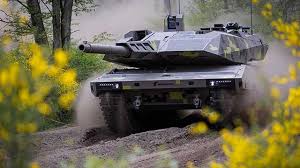Italy eyes 132 German Panther tanks, 1,000 Lynx armored vehicles

Italy is making a bold move in the realm of defense, recently securing parliamentary approval for a massive €8.2 billion plan to modernize its military arsenal. This ambitious program, set to kick off in 2025 and run until 2038, aims to bolster Italy’s military capabilities by acquiring state-of-the-art tanks and armored vehicles.
With €5.4 billion already allocated and the remaining €2.8 billion earmarked for future budgets, the initiative is poised to transform the Italian armed forces.
At the heart of this modernization effort lies the procurement of 132 Panther Kf-51 tanks and 1,000 Lynx Kf-41 armored vehicles from German manufacturer Rheinmetall. The Italian defense company Leonardo has partnered with Rheinmetall to establish a joint venture focused on developing new combat vehicles, signifying a significant leap towards enhanced military cooperation and innovation. In addition to the tanks and armored vehicles, Italy plans to acquire 140 specialized units tailored for engineering, reconnaissance, and bridge-laying operations by 2038.
The reactions to this landmark decision have been mixed across Italy. On one hand, there is palpable excitement surrounding the modernization of the military, seen as a necessary step in adapting to contemporary security challenges. Roberto Cingolani, CEO of Leonardo, views the collaboration with Rheinmetall as a critical move toward establishing a “European defense space,” aligning Italy’s military capabilities with broader European defense objectives.
He believes this partnership not only solidifies Italy’s position as a leader in advanced combat systems but also lays the groundwork for long-term cooperation and innovation in defense technology. Cingolani dubbed the initiative a “seed for a safer Europe,” emphasizing its potential to serve as a model for future European defense integration.
On the other hand, some political factions and commentators express skepticism about the heavy investment required for this plan. They voice concerns regarding budget allocations amid pressing national fiscal needs and the implications for Italy’s defense autonomy.
Critics highlight the risks associated with relying heavily on foreign technology, suggesting that such dependence could undermine Italy’s sovereignty in defense matters. The significant financial commitment raises questions about prioritizing military spending over other critical areas of public investment.
Despite these concerns, the strategic advantages of acquiring Panther tanks and Lynx armored vehicles cannot be overlooked. The Panther Kf-51 represents a new generation of military technology, boasting a more powerful 130mm cannon compared to the 120mm used in the Leopard 2A8.
This enhancement promises greater firepower against heavily armored adversaries, crucial for addressing modern battlefield requirements. Moreover, the Panther features an automated loading system that reduces crew size, improving operational safety and efficiency.
The implications of Italy’s decision extend beyond mere hardware acquisition. By forging partnerships with Rheinmetall and developing local manufacturing capabilities, Italy positions itself as a key player in the European defense industry. This collaboration not only aims to refresh the Italian military’s equipment but also seeks to foster industrial and technological expertise in military technologies, ensuring that Italy remains at the forefront of defense innovation.
As Italy embarks on this journey of military modernization, it is also reaffirming its commitment to NATO and the European Union, reinforcing its role in collective security initiatives. The decision to pivot toward new technology like the Panther Kf-51 highlights Italy’s desire for greater operational autonomy and flexibility in the face of evolving global threats.
Ultimately, Italy’s shift towards the Panther Kf-51 is not just about acquiring new tanks; it reflects a strategic recalibration aimed at enhancing national security and bolstering European defense solidarity.
As the nation prepares to embark on this ambitious program, it stands at a crossroads, balancing the imperatives of modern military readiness with the challenges of economic prudence and technological dependency. In this intricate landscape, the stakes are high, and the outcome of this modernization initiative will shape Italy’s defense posture for decades to come.





